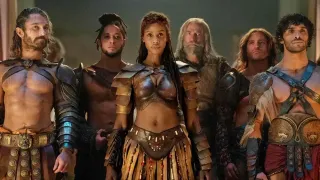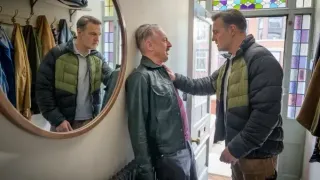December 4, 2015
Bikes vs Cars
Kilian Melloy READ TIME: 7 MIN.
Being a bicycle commuter, the documentary "Bikes vs Cars" didn't have a lot to tell me about the perspective of cyclists that I didn't already know. There's a sad point in the film during which friends of a young woman killed in Sao Paulo install a "ghost bike" in her honor at the place where a city bus forced her into a lane of traffic where a second bus struck and killed her. I've had the exact same situation happen, minus the getting killed part -- I was lucky. Even so, drivers behind me, evidently under the illusion that I could go faster -- or, perhaps, levitate -- started leaning on their horns. That's the crux of the problem: A guy on a bike weighs maybe 200 pounds, total (in my case considerably less) and travels at, say, 25 miles per hour. A car is a ton or so of bulk, and it wants to go fast -- much faster than bicycles travel. To a driver in an SUV, I'm sure a bicyclist seems about as significant, and as irritating, as a gnat.
What is it about the automobile that turns otherwise (presumably) rational people into foaming beasts? What is it about the automobile's construction that alters human physiology in such a way that people cannot work the brake pedal without also hitting the horn? (Or, in more pathological cases, leaves people unable to work the brake pedal at all?) That's the movie I'd like to see, and I'm still waiting to see it.
But "Bikes vs Cars" does look at the phenomenon of our global automotive culture from a number of interesting angles. The history of the car's rise is a fascinating one -- who knew that at the turn of the 20th century, Los Angeles was a bike commuter-friendly place, to the extent that there was an elevated boardwalk dedicated to bike traffic? Sadly, this film informs us, the automotive industry (GM in particular) went to great lengths to target and demolish the Los Angeles public transportation system, once the most extensive such system in the world. The eventual result, despite ever-expanding roadways? Endless gridlock.
The same is true elsewhere, as well. Mumbai; Lahore; Paris; London. Just about any large city is besieged by cars, and while automobiles probably do make many things in life more pleasant (or even possible), the cost is staggering. Aside from the obvious environmental impact, there's the sheer number and size of cars. 60 percent of Sao Paolo, we're told, houses cars... not people. 70 percent of the land area of greater Los Angeles is devoted to roads and parking lots. We're not living on Planet Fitness, we're trapped on Planet Tarmac.
But there's more. The movie offers tantalizing tidbits of information that startle even the jaded viewer: Americans spend the equivalent of 53 days per year just sitting in their cars, trying to get from place to place, and they devote 25 percent of their incomes to their cars. It's not as simple a matter of trying to get to and from work -- though, modern city planning being what it is, with suburbs relying heavily on the automobile, that's certainly part of it. But the commute is only half the story -- literally. One of the film's real shockers is that 50 percent of car trips in the U.S. are to destinations that are less than three miles away. (I once had a next door neighbor who routinely drove his car to the store across the street to get a half gallon of milk. I mean... really?)
So, what's behind a love, devotion, and reliance on cars that far exceeds anything resembling the reasonable and pragmatic? The film offers some thoughts on this, too. In Bogota, one interview subject offers the notion that it's the social perception of cars as signaling socio-economic status that makes automobile ownership desirable. A Los Angeles bicycle enthusiast echoes this, saying that the primacy given to cars results directly from endless propaganda -- and you sense he has a point, because turn on the TV and no matter what channel you're watching, you're going to see car ads. No matter who you are, what you like, and what you want to project to the world -- so says one fellow who speaks to the camera -- there are ads telling you which car will fit you.
But the film, while not remotely evenhanded, does give some time to the opposite point of view. A cabbie in Copenhagen points out the headaches of trying to navigate in one of the world's most bike-friendly cities (the other is Amsterdam... and neither Denmark nor The Netherlands has a national car industry; more than a coincidence)? Aside from the sheer number of bikes the cabbie must contend with, there's the not inconsiderable matter of cyclists not minding the rules of the road, sometimes cluelessly but other times aggressively. (It's almost a perfect mirror image to what a cyclist sees in most cities, with the far more numerous cars on the road being driven in ways that range from careless to thoughtless to homicidal.)
We hear also from a fellow who works in marketing and tells us -- while attending a vintage car show -- that the people who run the automotive industry want the same things we all want: Better air, better gas mileage, a more sustainable future. He talks a good game, but the facts (and tires) on the ground argue against his simplistic apologia: In 2012, the planet had one billion cars. By 2020, that number will have doubled. Good luck during rush hour.
The most dubious voice of the anti-bike, pro-car crowd is former Toronto mayor Rob Ford, a poster child for the unhealthy automobile-reliant lifestyle. Swept into office partly by a groundswell of support by suburban voters, Ford commenced straight away to attack any semblance of bike culture in the city, going so far as to do away with designated bike lanes that had been installed only couple of years earlier. (Ford, who tipped the scales at 330 pounds, turned out to have problems with drugs and alcohol as well, which, one might venture to argue, makes him less than ideal as either a mayor or a representative of the average car owner.)
But the fact remains that cars are bad for the planet in a variety of ways. Moreover, they are bad for society; and they're bad for human health, both physically and psychologically. They make modern life and commerce possible, but that's only because modern life and commerce often function on a "most minimally workable denominator" basis. If I had to recommend a movie to explain a cyclist's perspective, this would the one -- even though I fully expect that a significant percentage of car-drivers watching this would cheer at the part where it's reported that a cyclist has had his arm torn off by a speeding car in a hit and run. (The driver later tries to get rid of the limb by tossing it into a creek.)
Yes, I know what car drivers think of bike riders: I hear it all the time. One fellow movie critic at a different publication who wrote an essay about his biking lifestyle saw a barrage of hostile emails in response to his piece. ("Hostile" is a polite word for it.) Then there was the time when, posting about a bike accident that happened just before I happened on the scene, I garnered the following response: "He won't run the light next time." (The only possible rejoinder to this would have been to tell the guy who wrote that to pull the plywood out of his own eye; I don't have time or space here to detail the number of times in a given week I see cars speeding through red lights, making sudden right turns that cut across the bike lane without signaling, or decide that the bike lane is nothing but extra space to be used for their motoring pleasure.)
The film's penultimate line of dialogue is an excellent summation of the cyclist's perspective: "You own a car, not the street; the street belongs to all of us." Naturally, people in cars have little idea of what it's actually like to ride on the roads that we all, as taxpayers, theoretically own: Bike lanes are the dominion of potholes and utility access points, the haven of cabbies and stopping buses, the hang-out spots for motorists too lazy, rushed, or selfish to find proper parking, and a jungle of doors flung open by people in parked cars who have zero sense that right next to their vehicle there's an honest to god lane of traffic.
But everyone can stop and marvel at what happened a couple of years ago when one of the most heavily trafficked roads in Los Angeles -- the 405 Freeway -- had to be closed down over a weekend for road work. The panicked meme of impending "carmageddon" filled the airwaves and the Internet, and people simply stayed away. Air quality improved 83 percent in the areas near the freeway in those couple of days. That's the sort of revelatory figure that can stop just about anyone in his tracks and make his ponder what really is possible, rather than accepting the status quo as a given.
That's why a film like this -- taking a global, historic view, putting the problems of car culture and the possible bike-based solutions to some of those problems into context and perspective -- is such a welcome development. Now, if only people would climb out of their SUVs and take the time to see this movie, hear its message, and think about what our addiction to cars means, that would be an amazing thing -- and it might even lead to some real and constructive change.






